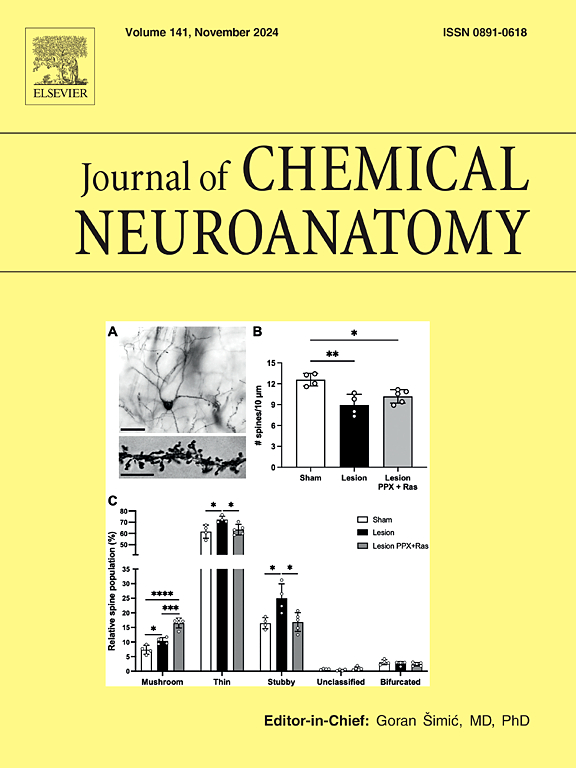Chronic pramipexole and rasagiline treatment enhances dendritic spine structural neuroplasticity in striatal and prefrontal cortex neurons of rats with bilateral intrastriatal 6-hydroxydopamine lesions
IF 2.1
4区 医学
Q3 BIOCHEMISTRY & MOLECULAR BIOLOGY
引用次数: 0
Abstract
Parkinson's disease manifests as neurological alterations within dendritic spines in the striatal and neocortical brain regions, where their functionality closely correlates with morphology. However, the impact of current pharmacotherapy on dendritic spine neuroplasticity, crucial for novel drug development in neurological and psychiatric disorders, remains unclear. This study investigated the effects of 6-OHDA intrastriatal bilateral lesions in male adult rats on behavior and dendritic spine neuroplasticity in striatal and cortical neurons. Furthermore, it evaluated the influence of chronic co-administration of pramipexole (PPX), a D3 receptor agonist, and rasagiline (Ras), a selective MAO-B inhibitor, on these alterations. Lesioned animals exhibited impaired balance behavior, with no improvement following PPX-Ras treatment. The 6-OHDA lesion decreased dendritic spine density in caudate putamen (CPU) spiny projection neurons (SPNs), a change unaffected by treatment, though PPX-Ras increased mushroom spines and reduced stubby spines in these neurons. In nucleus accumbens (NAcc) SPNs and prefrontal cortex layer 3 (PFC-3) pyramidal cells, dendritic spine density remained unaltered, but PPX-Ras decreased mushroom spines and increased bifurcated spines in the NAcc, while increasing mushroom spines and decreasing stubby spines in PFC-3 in lesioned rats. These findings emphasize the importance of dendritic spines as promising targets for innovative pharmacotherapies for Parkinson’s disease.
慢性普拉克索和拉沙吉林治疗可增强双侧椎管内6-羟基多巴胺损伤大鼠纹状体和前额叶皮层神经元树突棘结构的神经可塑性。
帕金森病表现为纹状体和新皮质脑区树突棘的神经改变,其功能与形态密切相关。然而,目前的药物治疗对树突棘神经可塑性的影响仍不清楚,而树突棘神经可塑性对神经和精神疾病的新药开发至关重要。本研究调查了雄性成年大鼠6-OHDA椎体内双侧损伤对纹状体和皮质神经元行为和树突棘神经可塑性的影响。此外,该研究还评估了长期联合使用 D3 受体激动剂普拉克索(PPX)和选择性 MAO-B 抑制剂拉沙吉兰(Ras)对这些改变的影响。病变动物表现出平衡行为受损,PPX-Ras治疗后未见改善。6-OHDA损伤降低了尾状体普门(CPU)棘投射神经元(SPNs)的树突棘密度,这一变化不受治疗的影响,但PPX-Ras增加了这些神经元的蘑菇棘,减少了粗壮棘。在病变大鼠的伏隔核(NAcc)SPNs和前额叶皮层第3层(PFC-3)锥体细胞中,树突棘密度保持不变,但在NAcc中,PPX-Ras会减少蘑菇状棘突,增加分叉棘突,而在PFC-3中,蘑菇状棘突会增加,矮小棘突会减少。这些发现强调了树突棘作为帕金森病创新药物治疗靶点的重要性。
本文章由计算机程序翻译,如有差异,请以英文原文为准。
求助全文
约1分钟内获得全文
求助全文
来源期刊

Journal of chemical neuroanatomy
医学-神经科学
CiteScore
4.50
自引率
3.60%
发文量
87
审稿时长
62 days
期刊介绍:
The Journal of Chemical Neuroanatomy publishes scientific reports relating the functional and biochemical aspects of the nervous system with its microanatomical organization. The scope of the journal concentrates on reports which combine microanatomical, biochemical, pharmacological and behavioural approaches.
Papers should offer original data correlating the morphology of the nervous system (the brain and spinal cord in particular) with its biochemistry. The Journal of Chemical Neuroanatomy is particularly interested in publishing important studies performed with up-to-date methodology utilizing sensitive chemical microassays, hybridoma technology, immunocytochemistry, in situ hybridization and receptor radioautography, to name a few examples.
The Journal of Chemical Neuroanatomy is the natural vehicle for integrated studies utilizing these approaches. The articles will be selected by the editorial board and invited reviewers on the basis of their excellence and potential contribution to this field of neurosciences. Both in vivo and in vitro integrated studies in chemical neuroanatomy are appropriate subjects of interest to the journal. These studies should relate only to vertebrate species with particular emphasis on the mammalian and primate nervous systems.
 求助内容:
求助内容: 应助结果提醒方式:
应助结果提醒方式:


